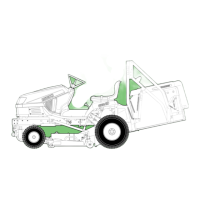
Do you have a question about the Iseki SXG19H-UGE and is the answer not in the manual?
| Cutting Width | 1220 mm |
|---|---|
| Transmission | Hydrostatic |
| Fuel Type | Diesel |
| Cylinders | 3 |
| Engine Type | Diesel |
| Engine Power | 19 HP |
| Collector Capacity | 550 L |
| Fuel Tank Capacity | 21 liters |
| Cutting Height | 25-90 mm |
Guidance on safe operating practices and personal protective equipment for lawn mower operators.
Checks and preparations required before starting the lawn mower to ensure safe operation.
Instructions for the safe and correct operation of the lawn mower during use.
Specific precautions and techniques for operating the lawn mower on sloped terrain.
Safety guidelines and procedures for refueling the lawn mower to prevent fire hazards.
General safety precautions and guidelines for performing maintenance on the lawn mower.
Safety precautions and procedures for inspecting and servicing the lawn mower's electrical system.
Detailed instructions for preparing and storing the lawn mower for extended periods.
Identification and location of all safety caution labels on the lawn mower and its components.
Guidance on seeking assistance for breakdowns or questions regarding the lawn mower.
Description and function of indicators and switches on the lawn mower's control panel.
Explanation of the function and operation of the lawn mower's control pedals.
List of essential checks to perform before starting daily operation of the lawn mower.
Step-by-step procedure for starting the lawn mower engine safely.
Procedure for safely bringing the lawn mower to a complete stop.
How to check and maintain the correct engine oil level for optimal performance.
Instructions for checking and maintaining the engine coolant level.
Procedure for inspecting and cleaning the air cleaner element.
Procedure for inspecting the fan belt tension and condition.
Instructions for adjusting the brake system for proper function.
Procedure for adjusting the neutral position of the hydrostatic transmission (HST).
Safety precautions and procedures for inspecting and handling the battery.
Step-by-step instructions for replacing engine oil, including capacity and frequency.
Instructions for replacing transmission oil, including frequency and components.
Procedure for cleaning the radiator and radiator screen to maintain cooling efficiency.
Step-by-step guide for draining, flushing, and refilling the engine coolant.
Procedures to verify the proper function of safety switches before operation.
Table outlining regular inspection and maintenance schedules for the lawn mower.
Detailed instructions for preparing and storing the lawn mower for extended periods.
Common engine-related problems, their causes, and recommended solutions.
Diagnosing and resolving problems related to the lawn mower's lift system.
Troubleshooting guide for issues encountered with the steering system.
Troubleshooting for issues with electrical components like lights, battery, and fuel pump.
Step-by-step instructions for mounting the mower deck onto the lawn mower.
How to adjust the cutting height of the mower deck using the setting holes.
Procedure for starting mowing operations, including raising the deck and engaging PTO.
Actions to take in case of an emergency during lawn mower operation.
Tips and techniques for achieving efficient and effective mowing.
How to inspect and replace the gear case oil for the mower deck.
How to inspect, replace, and correctly install the mower deck blades.
Instructions for cleaning the mower deck, including blades and underside.
Schedule for periodic inspections and maintenance of mower deck components.
Identifying and resolving causes of excessive noise and vibration.
Procedure for safely removing the high dump collector from the lawn mower.
Pre-operation checks for the collector's safety systems and functionality.
How to inspect and adjust the length of the collector cylinder.
Schedule for periodic inspections and maintenance of collector components.
Diagnosing issues when the collector fails to move or operate.